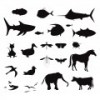I just read an article about conservationists in Brazil at the agricultural research agency (Embrapa) who are planning on cloning endangered animals using tissue samples collected from carcasses. The researchers want to clone animals that are not yet critically endangered in order to maintain them in captivity in the event that wild populations decline significantly.
Emprapa is planning to start with the maned wolf (Chrysocyon brachyurus), a species that is "near threatened" according to the IUCN Red List of endangered species. Other planned species include jaguars, black lion tamarins, bush dogs, collared anteaters, gray brocket deer, coatis, and bison.
Source:
- Log in to post comments
More like this
How's that for a frightening figure? 1/4 of all mammals on earth are on the IUCN's newest "Red List," animals threatened with extinction - that's 1,141 of them, at least, with 188 being 'critically endangered.' I say 'at least' because almost as many - 836 of them - are 'data deficient,' which…
I was going to try and do something non-furry to continue to explore cuteness on other branches of the tree of life, but this little guy just made my heart melt and I couldn't, in good conscience, post anything else.
HT ZoobornsThis adorable little cub is a Black Jaguar, born on April 14th in Peru…
The status of the world's vertebrates and conservation efforts were recently published in an article from Science Magazine. The study looked at various data covering the taxonomy, distribution, population, and threat status for 25,780 species of vertebrates (mammals, birds, amphibians, reptiles,…
"But wait," you say. "Anteaters aren't pets!" Well, I didn't think so either. But Salvador Dali had a pet anteater. And that's good enough for me.
Figure 1: Salvador Dali taking his pet anteater for a stroll. (Source)
The Giant Anteater, Myrmecophaga tridactyla, only eats ants and termites, making…



The effort is laudable but even if the genes of the clones are exactly 100% the same, the animals will not easily survive in the natural wild environment bacause they will lack the learnings passed onto them from their genetic parents and rude experience itself. They will have to be gently introduced to the wild environment until succeeding natural generations show ability to survive without human hand-holding.
The best solution to disappearing species is to curtail human activities in selected environments. As impractical as this is in most cases, it is the only long term answer.
Using the dna from carcasses implies that we are saving that which natural selection has and would have eliminated.
If this experiment goes forward and the progeny is tracked it would be very interesting to see if fate continues to eliminate
the subjects.
What advantage does cloning have over breeding progams?
they should try and get DNA from the remains of extinct animals
to try and bring some back